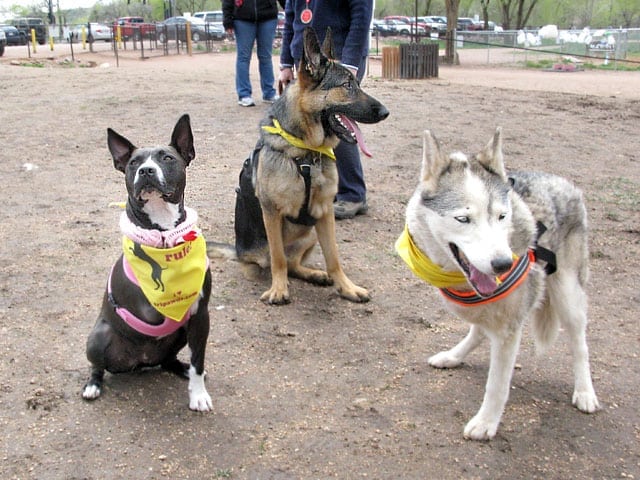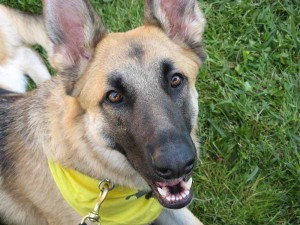The Tripawds crew has been working hard summarizing all of the Amputation and Cancer Care Survey submissions that pawrents have completed so far.
 As far as we know, the Amputation and Cancer Care Survey is the first of it’s kind to ever address amputation and the Tripawd lifestyle.
As far as we know, the Amputation and Cancer Care Survey is the first of it’s kind to ever address amputation and the Tripawd lifestyle.
We hope that pawrents will be able to see what others have experienced with their own Tripawds, and find the kind of information they need to make smart decisions for their pup.
Eventually you can download the information as one spreadsheet to draw and share your own conclusions, but first here’s some basic data for your review.
Meanwhile, please keep in mind that:
- We aren’t statisticians
- This is a small, relatively unscientific sampling
- Some questions were left blank within each survey
Tripawds Amputation and Cancer Care Survey Analysis Part 1:
Locations, Gender, Amputation Reasons and Surgery Side Effects
Where are All the Tripawds?
California Tripawds make up the majority of members, with 16 reponses from the Golden State. Texas and Colorado follow closely, and then the rest are thinly scattered in groups of 3 to 6 per state throughout North America. Overseas members from as far away as Portugal and New Zealand also responded but comprised less than 5 responses.
Reasons for Becoming a Tripawd
 Survey responses show that the number of male Tripawds to females is evenly split. But, bone cancer has affected more female pups than males here; 43 females became Tripawds because of bone cancer, versus 33 males.
Survey responses show that the number of male Tripawds to females is evenly split. But, bone cancer has affected more female pups than males here; 43 females became Tripawds because of bone cancer, versus 33 males.
Most interesting of all, it seems that more male Tripawds are missing a leg because of accidents and abuse (10 total), versus only three females.
Females
- Cancer = 43
- Accident = 3
- Birth Defect = 1
- Bacterial infection = 1
Males
- Cancer = 33
- Accident = 9
- Birth defect = 2
- Bacterial infection = 2
- Abuse = 1
Breeds Most Affected by Bone Cancer and Amputation
Most Tripawds members join the club because they’ve been diagnosed with bone cancer. According to the Veterinary Cancer Center of Santa Fe, each year over 8,000 dogs are diagnosed with bone cancer in the U.S., and most are large dogs. Our small survey sample backs this up.
Most Common Tripawd Breeds:
- German Shepherd / German Shepherd Mixes = 10
- Labrador / Labrador Mixes = 10
- Golden Retriever = 8
- Rottweiler = 7
Other Tripawd Breeds:
Alaskan Malamute = 1 (cancer)
All American=9 (4 cancer / 2 accident/injury / 1 birth defect / 1 unknown)
American Bulldog=2 (2 cancer)
Australian Kelpie Mix=1 (cancer)
Australian Shepherd=1 (accident)
Australian Shepherd Mix=1 (bacterial infection)
Belgian Sheepdog=1 (cancer)
Border Collie Cross=1 (cancer)
Boxer=1 (accident)
Boxer Husky Mix=1 (cancer)
Cane Corso=1 (cancer)
Chihuahua=1 (accident)
Deerhound=1 (cancer)
Doberman Mix=3 (3 cancer)
English Mastiff=1 (cancer)
English Shepherd=1 (cancer)
English Springer Spaniel=1 (bacterial infection)
Flat Coated Retriever=2 (2 cancer)
Flat Coated Retriever Mix w/Spaniel=1 (accident)
Great Dane=2 (cancer)
Great Pryenees Mix (Samoyed)=1 (bacterial infection)
Great Pyrenees Mix (Collie)=1 (cancer)
Greyhound=1 (cancer)
Jack Russell=1 (cancer)
Jindo=1 (accident)
Leonberger=1 (cancer)
Pitt Bull=2 (1 cancer / 1 bacterial infection)
Pitt Bull Mix=4 (cancer)
Rat Terrier=1 (accident)
Saint Bernard=1 (cancer)
Schnauzer = 1 (cancer)
Siberian Husky=4 (4 cancer)
Siberian Husky Mix w/Lab=1 (cancer)
Standard Poodle=1 (cancer)
Wheaten Terrier=1 (cancer)
Wolfdog=1 (cancer)
Common Post-Amputation Difficulties
While all dogs are different in how they respond to amputation surgery and recovery, the most common amputation surgery side effects are:
Bruising = 33
Emotional Distress=29
Appetite Loss=27
Restlessness=26
Mobility Problems=23
Seroma / Swelling=20
Constipation=17
Nausea=6
Bleeding=5
Diarrhea=3
Respiratory Problems=3
Phantom Pain = 1*
Three dogs were lucky enough to experience no symptoms at all!
Conclusion
 We hope this has given you some good background information on the Tripawd journey. If you would like us to present the information in a different way, have questions or would like to add your feedback, please do in the Tips and Resources Forum Discussion we started for this post.
We hope this has given you some good background information on the Tripawd journey. If you would like us to present the information in a different way, have questions or would like to add your feedback, please do in the Tips and Resources Forum Discussion we started for this post.
Stay tuned for our Downloads Blog post, where you’ll be able to download the survey in its entirety.
*We’re sure there are more Tripawds who experienced Phamtom Limb Pain, but we accidentally forgot to include it in the potential answers, and their pawrents didn’t mention it in the “other” field for this question.
 Join the forum discussion on this topic!
Join the forum discussion on this topic!
Interesting- when I added up all the “bully breeds” there were ten (I think- should probably count again to be sure!) and EIGHT were Tripawds due to cancer. And I don’t think I even got Kermit into the survey, so that’s 9 of 11.
Now, I didn’t add up any of the other types, but this seems pretty significant to me (as unscientific surveys go). 😉
My dog went into surgery for a hip replacement. The new hip gave him a femur fracture. The femur fractured again and it was recommended he have his hind limb amputated. During the amputation it was discovered that the bone was infected. He has MRSA. I see some dogs lost limbs due to infection. Did these dogs survive the infection? I searched your site and only saw Gretta’s story about infection…are there any others?
Thanks for asking! Sorry to hear about your pup. Did you search the forums for results about MRSA? You can also download the raw data from more than 100 Tripawds amputation survey results. Please consider starting a new topic in the discussion forums for more feedback from others.
Thankyou for such a quick reply and the search keywords. It was heartening to read a sucess story!